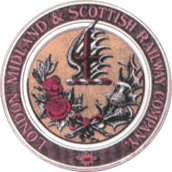LMS JOURNAL
Issues
LMSJ Issue 33
ISBN 978 1 905184 87 2
Contents
|

|
EDITORIAL
With one of the worst winters now over, it is pleasing to write this editorial during a sunny April day and to be able to look forward to Summer, a most enjoyable time when I can read manuscripts and look at photographs while sitting in the garden! In this issue we have a mixture of articles that should appeal to readers who are interested in the LMS during the years when it was an independent company and after 1948 when it was part of the nationalized British Railways system. Rather like the articles in our sister journal Midland Record, I believe the story of our railway system can only be told if you look at it 'from inception, through grouping into nationalization', and I hope this is how we present the story of the LMS.
I am always pleased to feature something different, and under this heading we have Neil Burgess's contribution on how the Somerset £ Dorset Joint Railway handled some aspects of road cartage, whilst from Keith Miles we have a railwayman's story of lodging turns and what it was like. Prior to the Second World War, lodging was commonplace, but after 1939 the number of lodging turns were reduced.
I recall being told by a driver that it was because of the problems of rationing; whether this is true I cannot say but in my experience during the 1950s, many turns that pre 1 93 9 could have been lodging turns, were now worked by one set of men from A to B and another set from B to C, and so on, rather than one set which could have gone from A to D. Another pleasing article by Keith Miles is about the old North Staffordshire Railway, my favourite small constituent company, and a further article about this line will appear in the next issue. Finally, a somewhat different article is by John Jennison, which examines the LMS Company's policy when purchasing locomotives from 'The Trade', as the private companies that built locomotive were known. I believe it is articles like this that makes our approach to recording railway history rather different from most, and is based upon the experience gained when editing the formative editions of Midland Record where I found that lesser known subjects attracted a lot of favourable reader comment.
Bob Essery
Site contents Copyright © Cygnet Magazines Limited, 2014-2025.




